Angilbert, Count of Ponthieu was a noble Frankish poet who was educated under Alcuin and served Charlemagne as a secretary, diplomat, and son-in-law. He is venerated as a pre-Congregation saint and is still honored on the day of his death, 18 February.

Charlemagne was King of the Franks from 768, King of the Lombards from 774, and Emperor of what is now known as the Carolingian Empire from 800, holding all these titles until his death in 814. Charlemagne succeeded in uniting the majority of Western Central Europe, and was the first recognized emperor to rule in the west after the fall of the Western Roman Empire approximately three centuries earlier. Charlemagne's rule saw a program of political and social changes that had a lasting impact on Europe in the Middle Ages.

Filioque, a Latin term meaning "and from the Son," was added to the original Nicene Creed, and has been the subject of great controversy between Eastern and Western Christianity. The term refers to the Son, Jesus Christ, with the Father, as the one shared origin of the Holy Spirit. It is not in the original text of the Creed, attributed to the First Council of Constantinople (381), which says that the Holy Spirit proceeds "from the Father" without the addition "and the Son".
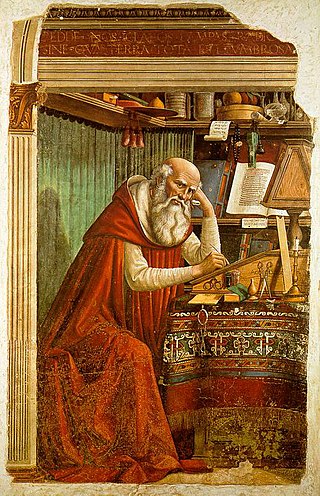
The Liber Pontificalis is a book of biographies of popes from Saint Peter until the 15th century. The original publication of the Liber Pontificalis stopped with Pope Adrian II (867–872) or Pope Stephen V (885–891), but it was later supplemented in a different style until Pope Eugene IV (1431–1447) and then Pope Pius II (1458–1464). Although quoted virtually uncritically from the 8th to 18th centuries, the Liber Pontificalis has undergone intense modern scholarly scrutiny. The work of the French priest Louis Duchesne, and of others has highlighted some of the underlying redactional motivations of different sections, though such interests are so disparate and varied as to render improbable one popularizer's claim that it is an "unofficial instrument of pontifical propaganda."
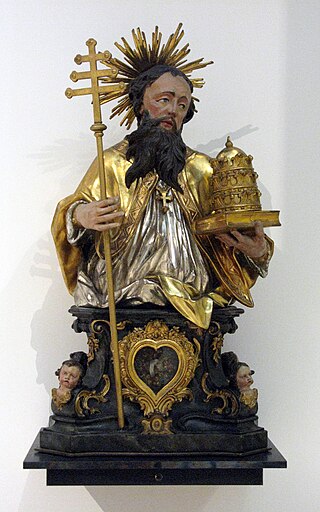
Pope Linus was the bishop of Rome from c. AD 67 to his death. He is generally regarded as the second Bishop of Rome, after St. Peter. As with all the early popes, he was canonized.
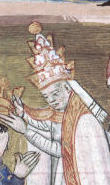
Pope Adrian I was the bishop of Rome and ruler of the Papal States from 1 February 772 to his death. He was the son of Theodore, a Roman nobleman.
Pope Benedict III was the bishop of Rome and ruler of the Papal States from 29 September 855 to his death.

Pope Zachary was the bishop of Rome from 28 November 741 to his death. He was the last pope of the Byzantine Papacy. Zachary built the original church of Santa Maria sopra Minerva, forbade the traffic of slaves in Rome, negotiated peace with the Lombards, and sanctioned Pepin the Short's usurpation of the Frankish throne from Childeric III. Zachary is regarded as a capable administrator and a skillful and subtle diplomat in a dangerous time.
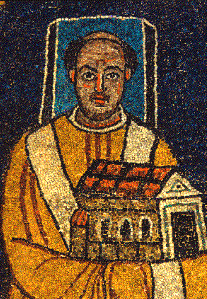
Pope Paschal I was the bishop of Rome and ruler of the Papal States from 25 January 817 to his death in 824.

Pope Evaristus was the bishop of Rome from c. 99 to his death c. 107. He was also known as Aristus and is venerated as a saint in the Eastern Orthodox Church, the Catholic Church, and Oriental Orthodoxy. It is likely that John the Apostle died during his reign period, marking the end of the Apostolic Age.
Pope Nicholas I, called Nicholas the Great, was the bishop of Rome and ruler of the Papal States from 24 April 858 until his death. He is remembered as a consolidator of papal authority, exerting decisive influence on the historical development of the papacy and its position among the Christian nations of Western Europe. Nicholas I asserted that the pope should have suzerainty over all Christians, even royalty, in matters of faith and morals.

Saint Paulinus II was a priest, theologian, poet, and one of the most eminent scholars of the Carolingian Renaissance. From 787 to his death, he was the Patriarch of Aquileia. He participated in a number of synods which opposed Spanish Adoptionism and promoted both reforms and the adoption of the Filioque into the Nicene Creed. In addition, Paulinus arranged for the peaceful Christianisation of the Avars and the alpine Slavs in the territory of the Aquileian patriarchate. For this, he is also known as the apostle of the Slovenes.
Drogo was a Frankish nobleman of the Pippinid family and the eldest son of Carloman, mayor of the palace of Austrasia under the Merovingian king Childeric III. He succeeded to his father's office in 747 but was soon squeezed out of power by his uncle, Pippin III, the mayor in Neustria. He resisted his uncle's takeover, but in 753 was captured and forced to become a monk.

The Fourth Council of Constantinople was the eighth ecumenical council of the Catholic Church held in Constantinople from 5 October 869, to 28 of February 870. It was poorly attended, the first session by only 12 bishops and the number of bishops later never exceeded 103. In contrast the pro-Photian council of 879–80 was attended by 383 bishops. The Council met in ten sessions from October 869 to February 870 and issued 27 canons.
A number of significant councils of the Latin Church were held at Aachen in the early Middle Ages.

In the 9th century, Christianity was spreading throughout Europe, being promoted especially in the Carolingian Empire, its eastern neighbours, Scandinavia, and northern Spain. In 800, Charlemagne was crowned as Holy Roman Emperor, which continued the Photian schism.
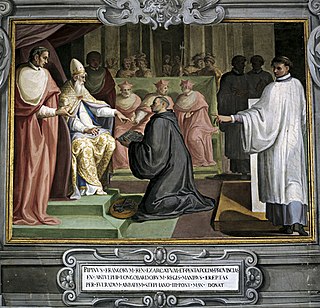
From 756 to 857, the papacy shifted from the influence of the Byzantine Empire to that of the kings of the Franks. Pepin the Short, Charlemagne, and Louis the Pious had considerable influence in the selection and administration of popes. The "Donation of Pepin" (756) ratified a new period of papal rule in central Italy, which became known as the Papal States.
The history of the filioque controversy is the historical development of theological controversies within Christianity regarding three distinctive issues: the orthodoxy of the doctrine of procession of the Holy Spirit as represented by the Filioque clause, the nature of anathemas mutually imposed by conflicted sides during the Filioque controversy, and the liceity (legitimacy) of the insertion of the Filioque phrase into the Nicene Creed. Although the debates over the orthodoxy of the doctrine of procession and the nature of related anathemas preceded the question of the admissibility of the phrase as inserted into the Creed, all of those issues became linked when the insertion received the approval of the Pope in the eleventh century.
The Council of Constantinople of 867 was a major Church Council, convened by Emperor Michael III of Byzantium and Patriarch Photios I of Constantinople in order to address several ecclesiastical issues, including the question of Papal supremacy in the Church, and the use of Filioque clause in the Creed.

An earthquake originating in the Central Apennines was felt in Rome and Spoleto on 29 April 801. It is reported in two independent contemporary sources, Einhard's Royal Frankish Annals and the Liber Pontificalis. The information provided by the written sources has been augmented by archaeology.














